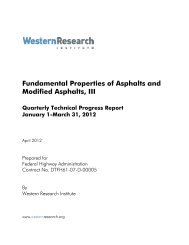Fundamental Properties of Asphalts and Modified Asphalts, III
Fundamental Properties of Asphalts and Modified Asphalts, III
Fundamental Properties of Asphalts and Modified Asphalts, III
Create successful ePaper yourself
Turn your PDF publications into a flip-book with our unique Google optimized e-Paper software.
SUBTASK 2-3. NANOTECHNOLOGY: AFM ANALYSIS OF ASPHALT THIN-FILM<br />
MICROSTRUCTURE PHENOMENOLOGY<br />
Task Manager: T. Pauli<br />
Personal: W. Grimes, J. Miller, J. Beiswenger<br />
Statement <strong>of</strong> Problem<br />
Asphalt pavements are known to fail over time by a combination <strong>of</strong> different mechanisms. The<br />
modes <strong>of</strong> failure <strong>of</strong> asphalt pavements that are commonly sited are embrittlement due primarily<br />
to steric <strong>and</strong> oxidative aging, fatigue cracking due primarily to loading cycles <strong>and</strong> moisture<br />
(traffic), rutting due primarily to densification <strong>and</strong> plastic flow, thermal cracking due primarily to<br />
low temperature embrittlement, <strong>and</strong> formation <strong>of</strong> potholes due primarily to breakdown <strong>of</strong> the<br />
sub-base structure. It is further contended in the pavement community that all <strong>of</strong> the<br />
aforementioned modes <strong>of</strong> failure are some how influenced by environmental conditions like<br />
seasonal temperature swings <strong>and</strong> the presence <strong>of</strong> water. Why do pavements constructed to the<br />
same specifications <strong>and</strong> subjected to similar environmental conditions <strong>and</strong> traffic loading fail at<br />
different rates by different failure modes when different materials (e.g., asphalts <strong>and</strong> aggregates<br />
derived from different sources) are used to construct the pavement?<br />
Approach<br />
In this subtask we have asked the question why pavements constructed with asphalt derived from<br />
different crude sources, if all other variables were to be kept the same, perform differently in<br />
terms <strong>of</strong> moisture compounded fatigue resistance. For example, pavement cracking is <strong>of</strong>ten<br />
observed to form distinct patterns during the lifespan <strong>of</strong> the pavement. In many other fields <strong>of</strong><br />
material science, metallurgy for example, pattern forming cracking has been successfully<br />
correlated to the formation <strong>of</strong> microstructural grain boundaries which originate in these materials<br />
during casting [Cappelli et al. 2008; Bian <strong>and</strong> Taheri 2008]. This same pattern cracking<br />
phenomena can also be applied to paving materials [Robertson et al. 2005, 2006]. The approach<br />
will be to develop quick <strong>and</strong> inexpensive experimental techniques derived from other fields <strong>of</strong><br />
materials nano-science. Results from these tests can then be combined with chemo-mechanical<br />
models <strong>of</strong> asphalt-aggregate composite materials to predict pavement performance.<br />
Goal<br />
The goal <strong>of</strong> this work is to gain a more fundamental underst<strong>and</strong>ing <strong>of</strong> the composition <strong>of</strong> asphalt<br />
concrete paving materials <strong>and</strong> how it relates to pavement performance (specifically fatigue<br />
cracking/self healing compounded by the presence <strong>of</strong> moisture).<br />
Support <strong>of</strong> FHWA Strategic Goals<br />
This work plan supports the following FHWA focus areas. Pavement Design <strong>and</strong> Analysis: This<br />
work will provide a more fundamental underst<strong>and</strong>ing <strong>of</strong> the physico-chemical nature <strong>of</strong> asphaltbinder<br />
<strong>and</strong> chemo-mechanical properties <strong>of</strong> mastics as they relate to pavement performance.<br />
Optimum Pavement Performance: A more fundamental underst<strong>and</strong>ing <strong>of</strong> the physico-chemical<br />
45





